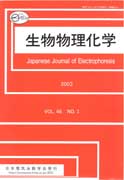All issues

Successor
Volume 46 (2002)
- Issue 4 Pages 163-
- Issue 3 Pages 129-
- Issue 2 Pages 27-
- Issue 1 Pages 1-
- Issue Supplement Page・・・
Volume 46, Issue 3
Displaying 1-5 of 5 articles from this issue
- |<
- <
- 1
- >
- >|
-
Kinue Ooi, Kaname Nakatani, Tsutomu Nobori, Yuko Sakurai, Yasuhiro Sum ...2002 Volume 46 Issue 3 Pages 129-134
Published: September 15, 2002
Released on J-STAGE: March 31, 2009
JOURNAL FREE ACCESSAbnormalities of serum lipid and lipoprotein concentrations are common in type II (non-insulin-dependent) diabetes mellitus. This study was to determine lipids and lipoprotein composition, and relationship between lipoprotein abnormalities and complications in diabetic patients. Lipoprotein profile was analyzed by simultaneous determination of serum cholesterol and triglyceride fractions. Modified LDL was quantified as relative change of the mobility shift of LDL fraction (charge modification frequency; CMF). 184 diabetic patients and 64 control subjects were analyzed by this method. No difference in fasting plasma glucose and hemoglobin A1c was observed between modified LDL positive and negative diabetic patients. In contrast, significant difference in conventional lipids, HDL/LDL fractions, appearance of IDL and distribution of lipoprotein phenotype by WHO classification were observed. In diabetic patients, increasing CMF had negative correlation with frequency of type IIa and positive correlation with type IIb and IV. Furthermore, increasing CMF was associated with a progression of nephropathy. Independent association was observed for retinopathy. We suggest that the serum lipoprotein pattern may provide an additional tool for monitoring the progression of hyperlipidemia and nephropathy in diabetes mellitus.View full abstractDownload PDF (1332K) -
Iwao Koyama, Shin-ichi Komine, Shigeru Hokari, Toshiyuki Matsunaga, Mi ...2002 Volume 46 Issue 3 Pages 135-141
Published: September 15, 2002
Released on J-STAGE: March 31, 2009
JOURNAL FREE ACCESSAlpha-amylases were purified from fasted rat livers to homogeneity by the consecutive three purification steps; fractionation by ammonium sulfate, ion-change chromatography and gel filtration. On the last step, the enzyme was eluted in the fractions after elution of cytochrome c. When liver from non-fasted rats were used, the liver amylase molecules formed a complex with glycogen, and the purification did not reach to homogeneity. The liver amylase activity was enhanced in a low blood glucose caused by fasting, suggesting that the liver amylase might participate partially in glycogen metabolism. In contrast, the enzyme activity in a spontaneous diabetic rats (BB rats) was lower in high blood glucose than that before the diabetic onset. There are no remarkable characteristics between the amylases obtained before and after the onset. However, the reduced activity in diabetic rats might be due to an inactivation of liver amylase, which was triggered by glycation, resulting in a partial breakdown of the amylase molecule.View full abstractDownload PDF (5051K) -
Yuji Nagasaka, Masanori Fujimoto, Kazuyuki Nakamura2002 Volume 46 Issue 3 Pages 143-146
Published: September 15, 2002
Released on J-STAGE: March 31, 2009
JOURNAL FREE ACCESSEffects of quercetin on the growth of JURKAT cells and the phosphorylation of MAP kinase families were examined. Quercetin inhibited the growth of JURKAT cells and induced DNA fragmentation. Quercetin enhanced the phosphorylation of ERK at 24h, and then inhibited at 48-96h. The phosphorylation of JNK was not affected by quercetin. The phosphorylation of p 38 MAPK was inhibited at 48-96h by quercetin. Thus, modulation of the phosphorylation state of MAP kinase families might be implicated in the quercetin action on the growth of JURKAT cells.View full abstractDownload PDF (2707K) -
Kayo Sugimoto, Emi Aoki, Ayako Kanazawa, Nobuo Hiratsuka, Yuriko Kurih ...2002 Volume 46 Issue 3 Pages 147-152
Published: September 15, 2002
Released on J-STAGE: March 31, 2009
JOURNAL FREE ACCESSMethods for separating proteins according to molecular weight are usually based on sodium dodecyl sulfate-polyacrylamide gel electrophoresis (SDS-PAGE). However, the toxicity of acrylamide and its handling during gel preparation constitute a significant problem. Therefore, we determined the molecular weights of proteins using agarose gel instead of polyacrylamide. We used the Mupid electrophoretic apparatus, because it is small, easy to use, and time-saving. We evaluated different types of agarose and buffer solutions, and parameters such as gel concentration, buffer SDS concentration, and quantity of gel (central thickness). The optimal gel was made from 5ml (central gel thickness 2mm) 4% NuSieve 3:1 agarose. An electrophoresis buffer containing 25mM Tris, 190mM glycine (pH8.3), and 0.1% SDS is optimal for protein separation. With this method, the standard curve was linear for reference proteins in the range of molecular weights from 14.4×103 to 97×103.View full abstractDownload PDF (7993K) -
Kazuko Sakaguchi, Jun Suzuki, Masaki Tanaka, Fumiaki Akahori2002 Volume 46 Issue 3 Pages 153-156
Published: September 15, 2002
Released on J-STAGE: March 31, 2009
JOURNAL FREE ACCESSIt is known that paraquat (PQ) induces pulmonary fibrosis in some species of animals (i.e. in rat) but not in others (i.e. in rabbit). We induced pulmonary fibrosis in rat and then under the comparable conditions we observed the process in the rabbit. We examined rats and rabbits plasma samples by micro two-dimensional polyacrylamide gel electrophoresis (M2D-PAGE) without denaturing agent, and also examined immunologically on anti-proteases (α1AT and α2M). The result showed that rat had one molecular species α1AT and four molecular isoformes of α2M. And in the rat which developed the pulmonary fibrosis, the decreases in α2M-1 and α1AT were observed. On the other hand, rabbit which under PQ administrations did not developed pulmonary fibrosis and had two isoformes of α2M and hardly recognized amount of α1AT, showed even increased α2M. The results suggest that the pulmonary fibrosis may associated the level of α2M and α1AT.View full abstractDownload PDF (5063K)
- |<
- <
- 1
- >
- >|